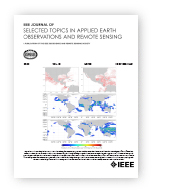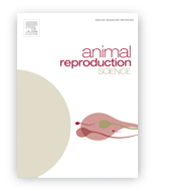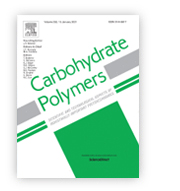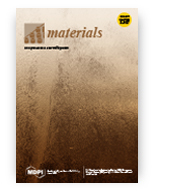Analyzing Different Parameterization Methods in GNSS Tomography Using the COST Benchmark Dataset
Zohreh Adavi, Witold Rohm, Robert Weber
IEEE Journal of Selected Topics in Applied Earth Observations and Remote Sensing
 GNSS tomography is an emerging remote sensing technique in the field of meteorology that is gaining increased attention in recent years. This method is used as a tool for atmospheric (particularly tropospheric) sensing and then applied in nowcasting and forecasting research. The tomographic approach can be used to determine the distribution of water vapor (WV), the most active component of the atmosphere. WV is one of the most important drivers of convection and precipitation. In this method, numerous line-of-sight integral observations at different locations and directions are used to derive a 3-D distribution of a WV structure. One of the challenges in GNSS tomography is that different parameterization methods are used for computing the design matrix. Here, the effect of the straight-line method versus the ray-tracing method is investigated for computing the length of a ray which passes through the model element. In addition, the effect of considering the topography of the area in the tomography model is analyzed. The accuracy of the developed model is verified using radiosonde measurements in the COST benchmark dataset. Results show that the Eikonal ray-tracing method is superior to other schemes whether used with topography or not. The mean values of RMSE of estimated wet refractivity with respect to the radiosonde profiles for these schemes are about 1.313 and 1.766 ppm, respectively. This work is conducted within COST Action ES1206 on “Advanced global navigation satellite systems tropospheric products for monitoring severe weather events and climate (GNSS4SWEC) (2013–2017)” and IAG Working Group “GNSS tomography.”
GNSS tomography is an emerging remote sensing technique in the field of meteorology that is gaining increased attention in recent years. This method is used as a tool for atmospheric (particularly tropospheric) sensing and then applied in nowcasting and forecasting research. The tomographic approach can be used to determine the distribution of water vapor (WV), the most active component of the atmosphere. WV is one of the most important drivers of convection and precipitation. In this method, numerous line-of-sight integral observations at different locations and directions are used to derive a 3-D distribution of a WV structure. One of the challenges in GNSS tomography is that different parameterization methods are used for computing the design matrix. Here, the effect of the straight-line method versus the ray-tracing method is investigated for computing the length of a ray which passes through the model element. In addition, the effect of considering the topography of the area in the tomography model is analyzed. The accuracy of the developed model is verified using radiosonde measurements in the COST benchmark dataset. Results show that the Eikonal ray-tracing method is superior to other schemes whether used with topography or not. The mean values of RMSE of estimated wet refractivity with respect to the radiosonde profiles for these schemes are about 1.313 and 1.766 ppm, respectively. This work is conducted within COST Action ES1206 on “Advanced global navigation satellite systems tropospheric products for monitoring severe weather events and climate (GNSS4SWEC) (2013–2017)” and IAG Working Group “GNSS tomography.”
10.1109/JSTARS.2020.3027909
Screening for structural variants of four candidate genes in dogs with disorders of sex development revealed the first case of a large deletion in NR5A1
Joanna Nowacka-Woszuk, Izabela Szczerbal, Monika Stachowiak, Stanisław Dzimira, Wojciech Niżański, Janusz Bieżyński, Tomasz Nowak, Maciej Gogulski, Marek Świtoński
Animal Reproduction Science
 Disorders of sex development (DSD) are important causes of infertility and sterility, and are risk factors for gonadal carcinogenesis. Many DSDs are caused by genetic factors, mainly sex chromosome abnormalities or mutations of genes involved in sexual development, as well as structural variants (SVs) - large deletions, duplications, and insertions, if these overlap genes involved in sex development. The aim of this study was to determine if there were SVs in four candidate genes - NR0B1 (DAX1), NR5A1, RSPO1, and SOX3 - using droplet digital PCR (ddPCR). There was study of two cohorts of dogs with DSD, including 55 animals with XX DSD and 15 with XY DSD. In addition, 40 control females and 10 control males were included in the study. Among cases, for which there were evaluations, a large deletion consisting of four exons of the NR5A1 gene was identified in a Yorkshire Terrier with a rudimentary penis, hypospadias, bilateral cryptorchidism, and spermatogenesis inactive testes. This is the first mutation in the NR5A1 gene leading to XY DSD phenotype to be reported in domestic animals. There were no SVs in the genes evaluated in the present study in the cohort of dogs with XX DSD. The results from this study provide evidence that the large structural variants of these genes are rarely associated with the DSD phenotype in dogs.
Disorders of sex development (DSD) are important causes of infertility and sterility, and are risk factors for gonadal carcinogenesis. Many DSDs are caused by genetic factors, mainly sex chromosome abnormalities or mutations of genes involved in sexual development, as well as structural variants (SVs) - large deletions, duplications, and insertions, if these overlap genes involved in sex development. The aim of this study was to determine if there were SVs in four candidate genes - NR0B1 (DAX1), NR5A1, RSPO1, and SOX3 - using droplet digital PCR (ddPCR). There was study of two cohorts of dogs with DSD, including 55 animals with XX DSD and 15 with XY DSD. In addition, 40 control females and 10 control males were included in the study. Among cases, for which there were evaluations, a large deletion consisting of four exons of the NR5A1 gene was identified in a Yorkshire Terrier with a rudimentary penis, hypospadias, bilateral cryptorchidism, and spermatogenesis inactive testes. This is the first mutation in the NR5A1 gene leading to XY DSD phenotype to be reported in domestic animals. There were no SVs in the genes evaluated in the present study in the cohort of dogs with XX DSD. The results from this study provide evidence that the large structural variants of these genes are rarely associated with the DSD phenotype in dogs.
10.1016/j.anireprosci.2020.106632
Superabsorbent crosslinked bacterial cellulose biomaterials for chronic wound dressings
Daria Ciecholewska-Juśko, Anna Żywicka, Adam Junka, Radosław Drozd, Peter Sobolewski, Paweł Migdał, Urszula Kowalska, Monika Toporkiewicz, Karol Fijałkowski
Carbohydrate Polymers
 In this work, we present a novel ex situ modification of bacterial cellulose (BC) polymer, that significantly improves its ability to absorb water after drying. The method involves a single inexpensive and easy-to-perform process of BC crosslinking, using citric acid along with catalysts, such as disodium phosphate, sodium bicarbonate, ammonium bicarbonate or their mixtures. In particular, the mixture of disodium phosphate and sodium bicarbonate was the most promising, yielding significantly greater water capacity (over 5 times higher as compared to the unmodified BC) and slower water release (over 6 times as compared to the unmodified BC). Further, our optimized crosslinked BC had over 1.5x higher water capacity than modern commercial dressings dedicated to highly exuding wounds, while exhibiting no cytotoxic effects against fibroblast cell line L929 in vitro. Therefore, our novel BC biomaterial may find application in super-absorbent dressings, designed for chronic wounds with imbalanced moisture level.
In this work, we present a novel ex situ modification of bacterial cellulose (BC) polymer, that significantly improves its ability to absorb water after drying. The method involves a single inexpensive and easy-to-perform process of BC crosslinking, using citric acid along with catalysts, such as disodium phosphate, sodium bicarbonate, ammonium bicarbonate or their mixtures. In particular, the mixture of disodium phosphate and sodium bicarbonate was the most promising, yielding significantly greater water capacity (over 5 times higher as compared to the unmodified BC) and slower water release (over 6 times as compared to the unmodified BC). Further, our optimized crosslinked BC had over 1.5x higher water capacity than modern commercial dressings dedicated to highly exuding wounds, while exhibiting no cytotoxic effects against fibroblast cell line L929 in vitro. Therefore, our novel BC biomaterial may find application in super-absorbent dressings, designed for chronic wounds with imbalanced moisture level.
10.1016/j.carbpol.2020.117247
Titanium Dioxide Thin Films Obtained by Atomic Layer Deposition Promotes Osteoblasts’ Viability and Differentiation Potential While Inhibiting Osteoclast Activity - Potential Application for Osteoporotic Bone Regeneration
Agnieszka Śmieszek, Aleksandra Seweryn, Klaudia Marcinkowska, Mateusz SIkora, Krystyna Lawniczak-Jablonska, Bartłomiej S. Witkowski, Piotr Kuzmiuk, Marek Godlewski, Krzysztof Marycz
Materials
 Atomic layer deposition (ALD) technology has started to attract attention as an efficient method for obtaining bioactive, ultrathin oxide coatings. In this study, using ALD, we have created titanium dioxide (TiO2) layers. The coatings were characterised in terms of physicochemical and biological properties. The chemical composition of coatings, as well as thickness, roughness, wettability, was determined using XPS, XRD, XRR. Cytocompatibillity of ALD TiO2 coatings was accessed applying model of mouse pre-osteoblast cell line MC3T3-E1. The accumulation of transcripts essential for bone metabolism (both mRNA and miRNA) was determined using RT-qPCR. Obtained ALD TiO2 coatings were characterised as amorphous and homogeneous. Cytocompatibility of the layers was expressed by proper morphology and growth pattern of the osteoblasts, as well as their increased viability, proliferative and metabolic activity. Simultaneously, we observed decreased activity of osteoclasts. Obtained coatings promoted expression of Opn, Coll-1, miR-17 and miR-21 in MC3T3-E1 cells. The results are promising in terms of the potential application of TiO2 coatings obtained by ALD in the field of orthopaedics, especially in terms of metabolic- and age-related bone diseases, including osteoporosis.
Atomic layer deposition (ALD) technology has started to attract attention as an efficient method for obtaining bioactive, ultrathin oxide coatings. In this study, using ALD, we have created titanium dioxide (TiO2) layers. The coatings were characterised in terms of physicochemical and biological properties. The chemical composition of coatings, as well as thickness, roughness, wettability, was determined using XPS, XRD, XRR. Cytocompatibillity of ALD TiO2 coatings was accessed applying model of mouse pre-osteoblast cell line MC3T3-E1. The accumulation of transcripts essential for bone metabolism (both mRNA and miRNA) was determined using RT-qPCR. Obtained ALD TiO2 coatings were characterised as amorphous and homogeneous. Cytocompatibility of the layers was expressed by proper morphology and growth pattern of the osteoblasts, as well as their increased viability, proliferative and metabolic activity. Simultaneously, we observed decreased activity of osteoclasts. Obtained coatings promoted expression of Opn, Coll-1, miR-17 and miR-21 in MC3T3-E1 cells. The results are promising in terms of the potential application of TiO2 coatings obtained by ALD in the field of orthopaedics, especially in terms of metabolic- and age-related bone diseases, including osteoporosis.
10.3390/ma13214817









